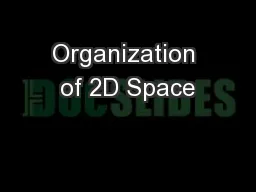

Proj 1 Linear Ligeti musical composition Music Notation Xenakis Metastatis Smooth Parallel Coordinates NY Times Sector Snapshot Linear Relational Audio Scrubber Art Lisa ID: 167248
Download Presentation The PPT/PDF document "Organization of 2D Space" is the property of its rightful owner. Permission is granted to download and print the materials on this web site for personal, non-commercial use only, and to display it on your personal computer provided you do not modify the materials and that you retain all copyright notices contained in the materials. By downloading content from our website, you accept the terms of this agreement.
Slide1
Organization of 2D SpaceSlide2
Proj
1: Linear (
Ligeti musical composition)Slide3
Music Notation: (
Xenakis
– Metastatis
)Slide4
Smooth Parallel CoordinatesSlide5
NY Times Sector SnapshotSlide6
Linear Relational (
Audio Scrubber
)Slide7
Art: Lisa
Jevbratt
(1:1 Interface
)Slide8
Linear
Time Graphs
Winter 2006
George Legrady
8Slide9
Mapping in 2D:
handmaps.orgSlide10
Two maps: Xenakis, Art practiceSlide11
Visual Organization
(Macro-micro, willi kunz)
Space
: Depending on their
visual placement within a given space, the
same
elements will assume
different
visual aspects of
weight
and
movement
.
Space is visually
subdivided
by the
tension
that develops between an
element
and the
boundaries
of the space
Size
and
proportion
of space are determined at the beginning
M M
M
M
M M Slide12Slide13
Motion, Movement Through Spatial Organization
A
space
becomes visually active when it is subdivided
Balance is achieved through interplay of
scale
,
sequence
, and
spatial position
Any object placed next to each other in an image defines a
relationship
through
spatial proximitySlide14
Positioning in 2D Space:
Eigenfactor
.orgSlide15
Mosaic Grid: Structure determines orderSlide16
Node MosaicSlide17
TreeMap
: Values determine order
NewsmapSlide18
TreeMap
:
SmartMoneySlide19
Visualizing knowledge domain
spatially using
Kohonen (Skupin)Slide20
Visual
Basic
Literacy: Basic Units
(Dondis
)
Dot
: Minimal unit, pointer, marker of space
Line:
Joins dots, articulator of space
Shape
: Line describes and encloses space
Direction
: Thrust of movement
Tone
: The intensity of lightness or darkness
Color
: Associative and symbolic meanings
Texture
: Quality of touching, looks/feels like
Scale
: Relative proportion & measurement
Dimensions
: 2D, 3D spatial illusion
Motion
: Visual elements guiding the viewerSlide21
Scale: Relative proportion & measurementSlide22
Visual Language & Syntax
Visual language:
Analogous & symbolic
Visual Syntax
: partially perceptual, partially conventual (cultural, learned)
Images represent. (They are abstracted information)
Meaning is constructed (assembled parts)
Visual Language
therefore requires apprenticeship (What you see is what you know)
2 Layers:
Denotative
: (literal message),
Connotative
(implied sub-text)
M M
M
M
M M Slide23
Weight, Im/Balance, Dis/Order, Un/Stable
Balance:
Physiological, psychological
H-V construct:
man to his environment
Stress
: Unstable causes stress
Stabilization: relative stress/balance
Lower-left
: most stable
Harmony
: (centered), no visual surprise
Search for balance with off-center mark
Ambiguity
: may obscure intent & meaning
Slightly off-center mark confounds
Visual elements in stress location: more weight
M
M
M
M
M
M
M M Slide24
Groupings
Attraction & Grouping
: 2 dots fight for attention in their interaction
Distanced:
Create individual statements as they repel each other
Close together:
The more complicated the forms they describe - There is an attraction force
Perception
: dictates to make whole out of units
Connect the dots!!
Visual phenomenon for astronomical signs
Opposites repel, similars attract
•
•
• •
•
• •
•
• Slide25
Structure: the Grid System
Modular
Grids: Modules determine the dimensions and placement of graphic and typographic elements
All elements are
consistently
placed according to the
pre-determined structure
once it has been defined
The grid functions as an
organizational
device, but stays
invisible
Structural order also requires
imagination
Design process: begin with
intuition
and
visual judgement,
follow with rational structureSlide26
Spatial Organization & Hidden Modular Grid
Development of a grid must proceed
from
an
evaluation of all the
visual material
to be included in the designSlide27Slide28